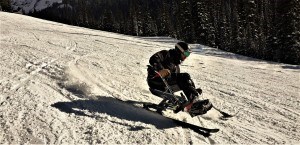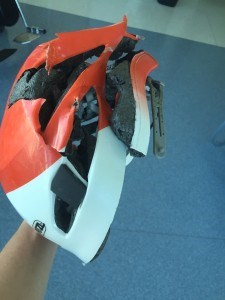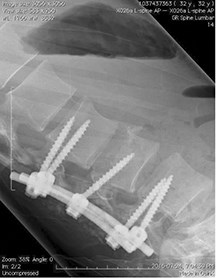
Seven-and-a-half months after he was told he might never be able to walk again, Ryan Titchener stood on two legs, if only for a few minutes, as though he had just conquered another mountain.
“It’s pretty cool to be home,” Titchener said, to thunderous applause and a standing ovation.
The momentous occasion was a homecoming of sorts for the local alpine guide after a freak accident in the Bugaboos nearly killed the 32-year-old last July.
To welcome Titchener home, more than 150 people packed the Royal Canadian Legion last week to hear from the man himself, who has not only learned to walk again, but has found a way to inspire others to overcome their challenges.
“I think people have this idea when you get a traumatic injury like this and you end up in a wheelchair that all of a sudden things have changed, but I’m still me,” said Titchener.
“I still want to do the same things I did before I’m just doing them in a different way.”
On July 15, 2016 Titchener and his girlfriend Tereza Turecká were making their way along the west ridge of Pigeon Spire, when a boulder the size of a washing machine came loose and crushed his body.
The damage was immediate. His T2 vertebra was cracked, his L3 lumbar had exploded, and he had 14 broken ribs. His left lung was also filling up with blood.
“The boulder rolled right over my body and it crushed me. My face literally hit my feet and snapped me in half,” recalled Titchener, who credits his helmet and his girlfriend for saving his life.
“I knew instantly that I was paralyzed.”

Conscious throughout the entire ordeal, Titchener tumbled nearly 10 metres down the mountain before eventually coming to a standstill, metres from where his girlfriend stood–albeit on his stomach hanging off the side of the ridge with life threatening injuries.
“She was amazing,” Titchener said of his girlfriend. “She was able to use her skills she learned at Marmot Basin as a ski patroller to stabilize me and up right me because of my potential head injury.”
After assessing his mental status and checking him for head injuries, she rummaged through his backpack and found the radio still in one piece.
“I couldn’t believe it,” said Titchener, about the state of the radio.
Turning it on, Turecká began yelling, “Mayday, mayday Pigeon Spire” into the radio.
Laying there hoping someone–anyone–heard their cry for help, they anxiously stared at the radio waiting for a response.
To make matters worse, the clouds quickly began closing in on the pair, pelting them with rain and hail.
“I just remember that green light coming on and I knew we picked someone up. Someone had heard what she just said.”
Crackling across the radio, they could hear two voices talking back and forth to each other confirming what they thought they had just heard.
As luck would have it, a search and rescue team out of Golden, B.C., was training in the valley eight kilometres away and was spurred into action.

But just as things were beginning to look up the weather had different plans, making a rescue seem impossible.
“A lot of time passed where we were chatting and talking and just trying to breathe,” said Titchener.
Four hours later they heard the swooshing blades of an approaching helicopter and watched it drop off supplies below them to lighten the load.
“It was like music to your ears, the best song you ever heard,” recalled Titchener.
With poor visibility, rescuers were contemplating several different strategies to get him off the mountain, but in a stroke of good luck the clouds briefly parted allowing the helicopter to come back and drop off two rescuers and equipment at Titchener’s feet.
“It was like something out of a movie,” he said, adding that if they ever do decide to make a movie, Brad Pitt had better play him.
After assessing his injuries and stabilizing him, rescuers put Titchener into a vacuum mattress to secure his broken back.
Packaged and ready for an evacuation, Mother Nature had different plans, dropping nearly six centimetres of snow in the course of an hour, stranding the entire group on the side of the mountain.
Wet and hypothermic, things weren’t looking good for Titchener, but just as quickly as the weather closed in on them it began to clear up.
“The worst pain I had wasn’t actually from the fall or from the four-plus hours on the mountain, it was when they lifted me up,” Titchener said, explaining the bag collapsed in on him when he was lifted off the ground crushing his already broken ribs.
After a quick flight to the valley bottom, he was transferred into a waiting helicopter and airlifted to the hospital in Golden.
In Golden, doctors immediately cut off his clothing and cut into the side of his chest to drain his lungs, which were full of blood.

“They just took a needle and stabbed it into the side of me, they didn’t knock me out or anything, they just jammed a tube right into the side of my body. I felt every last little bit of it,” said Titchener. “I don’t think you can kill me now.”
After stabilizing him, doctors realized he would need to get to a more advanced hospital so he could undergo spinal surgery. They quickly prepared him to be transported by ambulance to Foothills Medical Centre in Calgary because the weather was not cooperating.
After he arrived in Calgary doctors ran him through a series of x-rays, MRIs and CT scans to figure out the extent of his injuries.
The following day he underwent spinal surgery fusing his L2 vertebrae with his L4 vertebrae after removing the shattered remains of his L3 vertebrae.
Despite his initial prognosis that he would never be able to walk again he began rehab soon after his surgery and managed to stand up for the first time 79 days after his injury.
“For somebody who climbs mountains as their lifestyle to try to get from one side to the other it seems like a pretty easy task, but this was the hardest mountain I ever climbed in my life,” Titchener said, describing the bars at the gym to help him stand.
“I didn’t know what to do. I didn’t know where to tie in, where to step or grab, or anything, it was messed up. I always felt like I was on lead and it was the scariest lead of my life, it was run out and I was just alone up there, but I wasn’t ‘cause you guys were there too.”
Today Titchener is recovering from his injuries in Canmore and spends a lot of his time at Elevation Place, a local activity centre with a gym, pool and rock climbing wall.
“It’s like training for that marathon you might never run, that mountain you might never climb, which is kind of crazy because you don’t know how hard to work out, how far to push yourself and what it’s going to really accomplish,” said Titchener.
“It’s a daunting task, but I think that’s really comparable to a lot of tasks we have in life, you don’t really know the outcome, but that’s kind of the exciting part.”
Paul Clarke
[email protected]
